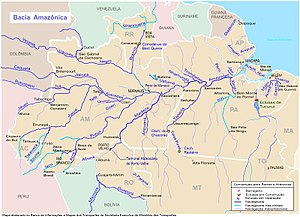
The Jaú National Park is a national park located in the state of Amazonas, Brazil. It is one of the largest forest reserve in South America, and part of a World Heritage Site.

Óbidos is a municipality in Pará, Brazil located at the narrowest and swiftest part of the Amazon River. It's an old town founded in 1697, and located between Santarém and Oriximiná. The town is the seat of the Diocese of Óbidos. The town was named after Óbidos, Portugal.

Rio Trombetas Biological Reserve is a federally-administered biological reserve in the municipality of Oriximiná, Pará, Brazil. It covers a large area of Amazon biome including rainforest, wetlands and water.

Jari Ecological Station is an ecological station in Brazil, located in the states of Amapá and Pará, created in 1984.

The Iriri River is a large tributary of the Xingu River in Brazil, in the state of Pará. It is 1,300 km (810 mi) long making it the 116th longest river in the world and the 15th longest in the Amazon basin. The headwaters are the traditional home of the Panará people.

Oriximiná is the westernmost and second-largest municipality in the Brazilian state of Pará. It is also the fourth-largest in the country.

The Cuminapanema River is a river of Pará state in north-central Brazil, a tributary of the Curuá River.

The Curuá River is a river of Pará state in north-central Brazil.

The Maicuru River is a river of Pará state in north-central Brazil, a tributary of the Amazon that discharges into that river via the Lago Grande de Monte Alegre.

The Paru de Oeste River is a tributary of the Trombetas River in Pará in north-central Brazil.

The Tapajós National Forest is a Brazilian national forest in the state of Pará, Brazil. It supports sustainable exploitation of the natural resources in an area of Amazon rainforest.

Terra Santa is a municipality in the state of Pará in the Northern region of Brazil.

Serra do Cachimbo is a low mountain range in Brazil, in the southern part of the state of Pará, located mostly in the municipalities of Altamira, Itaituba, Jacareacanga, and Novo Progresso.

The Grão-Pará Ecological Station (Portuguese: Estação Ecológica Grão-Pará is a strictly protected ecological station in the state of Pará, Brazil. It managed by the state of Pará. With 42,458 square kilometres of well-preserved Amazon rainforest it is the largest fully protected tropical forest conservation unit in the world.

The Jamanxim National Park is a national park in the state of Pará, Brazil.

The Nascentes da Serra do Cachimbo Biological Reserve is a biological reserve in the state of Pará, Brazil. The reserve protects an area in the transition between the Cerrado and Amazon biomes, supporting highly diverse flora and fauna including many endemic species. It is accessible via the BR-163 highway, and is among the federal conservation units in the Amazon Legal that has suffered most from deforestation.

Terra do Meio Ecological Station is an ecological station (ESEC) in the state of Pará, Brazil.

Mulata National Forest is a national forest in the state of Pará, Brazil.

The Saracá-Taquera National Forest is a national forest in the state of Pará, Brazil.

The Trombetas State Forest is a state forest in the state of Pará, Brazil.











